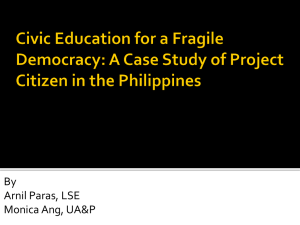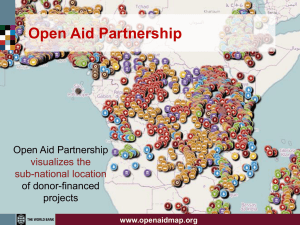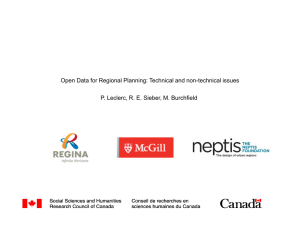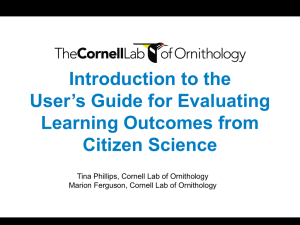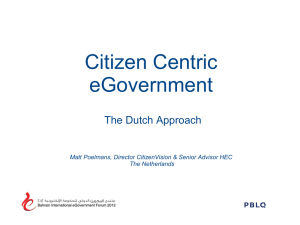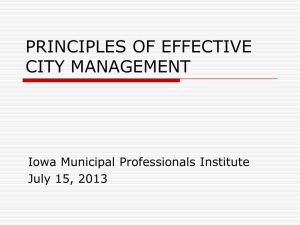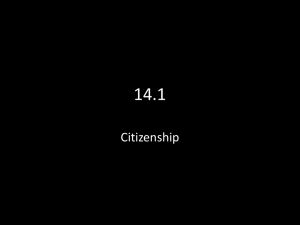Citizen Professional Approach - Collaborative Family Healthcare
advertisement
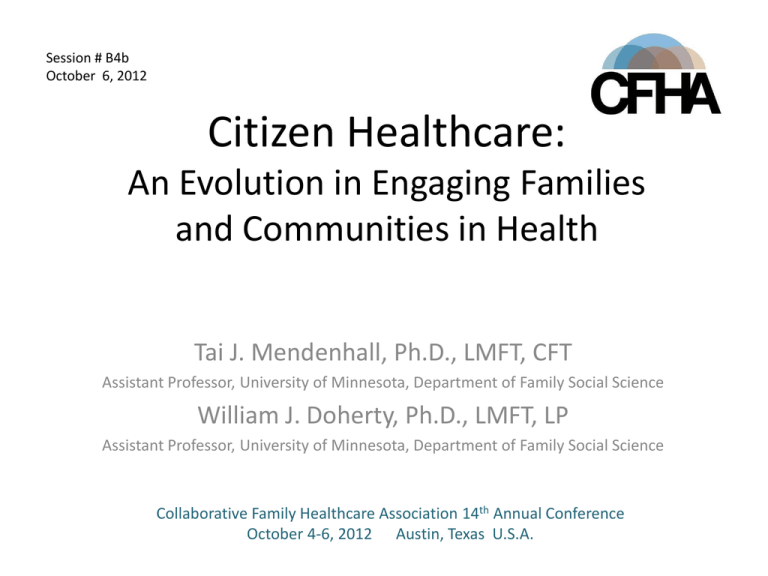
Session # B4b October 6, 2012 Citizen Healthcare: An Evolution in Engaging Families and Communities in Health Tai J. Mendenhall, Ph.D., LMFT, CFT Assistant Professor, University of Minnesota, Department of Family Social Science William J. Doherty, Ph.D., LMFT, LP Assistant Professor, University of Minnesota, Department of Family Social Science Collaborative Family Healthcare Association 14th Annual Conference October 4-6, 2012 Austin, Texas U.S.A. Faculty Disclosure We have not had any relevant financial relationships during the past 12 months. Objectives • At the conclusion of this presentation, the participant will be able to: – Describe the core tenets and principles of the Citizen Healthcare Model – Describe core action strategies for Citizen Healthcare projects – Describe how Citizen Healthcare has been applied across diverse community settings and mental health / physical health-related foci – Outline key differences between Citizen Healthcare and other models of collaborative and community-based work Introductions Conventional / “Standard” Care • Hierarchal structure – Provider/Patient – By Specialty • Provider-consumer design – Care as “goods/services” – Providers give, patients take • Expert-driven – Providers’ wisdom valued / Providers active – Patients’ wisdom untapped / Patients passive • Challenged by contemporary contexts… Healthcare: The Current Context • Rapid and constant change • From acute care to preventive and patientoriented care • From provider/consumer services to provider/patient partnership Trends toward Family & Community-based Interventions We are moving away from doing care “on” people to doing care “with” them Tapping into patients’ and families livedexperience and wisdom requires professionals to “unlearn” their expert-roles and work more collaboratively within the context(s) of more flattened professional hierarchies Citizen Health Care • Citizen Health Care (CHC) is a way to engage patients, families, and communities as coproducers of health and health care • CHC encompasses an identity-shift for professionals (from “expert” to “citizen”) • Core principles and planning strategies permeate projects, but no two projects look wholly alike Origins of Citizen Health Care • • • • • Family Therapy Medical Family Therapy Collaborative Family Health Care Democratic Political Theory Contemporary Community Organizing Strategies • Community Based Participatory Research Citizen Health Care (CHC): Core Principles • The greatest untapped resource for improving health care is the knowledge, wisdom, and energy of individuals, families, and communities who face challenging health issues in their everyday lives. Core Principles, con’t • People must be engaged as co-producers of health care for themselves and their communities, not just as patients or consumers of services. Core Principles, con’t • Professionals can play a catalytic role in fostering citizen initiatives when they develop their public skills as citizen professionals in groups with flattened hierarchies. Core Principles, con’t • If you begin with an established program, you will not end up with an initiative that is "owned and operated" by citizens. But a citizen initiative might create or adopt a program as one of its activities. Core Principles, con’t • Local communities must retrieve their own historical, cultural, and religious traditions of health and healing, and bring these into dialogue with contemporary medical systems. Core Principles, con’t • Citizen health initiatives should have a bold vision (a BHAG – a big, hairy, audacious goal) while working pragmatically on focused, specific projects. Examples Citizen Health Care Projects • Partners in Diabetes (Regions Hospital / UMN) • A Neighbor Giving Encouragement, Love and Support (“ANGELS”) (Wake Forest University) • Family Education / Diabetes Series (“FEDS”) (St. Paul Department of Indian Work / UMN) • Activated Patient Project (Como Clinic / UMN) • Students Against Nicotine & Tobacco Abuse (“SANTA”) (HHH Job Corps / UMN) Examples, con’t • Intimate Partner Violence (IPV) in the Hmong Community: Tacking an Old Problem in a New Way (Lao Family of Minnesota / UMN) • Reducing Tobacco Use in Southeast Asian Communities (MPAAT / UMN) • Hennepin County Citizen Professional Project (Hennepin County / UMN) • Sisters Together Overachieving in Raising Kids (“STORKS”) (Broadway Clinic / UMN) Family Diabetes / Education Series (the “FEDS”) • Members of the Native American community who have lived experience with diabetes (as patients or family members) working in partnership with providers in the provision of education and support in culturally appropriate ways • Designed and implemented through a democratic and collaborative partnership between patients, family members, and providers FEDS / Introduction • Engages low-income, urban-dwelling AIs and their families in an active forum of education, fellowship, and support • Participants include patients and family members (n = 40-60), medical and behavioral health providers (n = 4-5), and tribal elders (n = 4-6) FEDS / Meetings • Meetings start with members conducting foot checks and recording each other’s weight/ BMI, blood pressure, and blood sugar • Meals consistent with AI culture and traditions are prepared and shared communally, along with discussions about ingredients and indicated portion sizes FEDS / Education • Educational forums take place in the contexts of talking circles, small and large group discussions, and a variety of lively activities (e.g., traditional music, dancing and aerobics, impromptu theater/roleplays) • Forums encompass active collaboration between community leaders and Western providers FEDS / Educational Topics, con't ● Diabetes in the AI Community ● Dietary Guidelines & Portion Sizes ● Exercise & Physical Activity ● Obesity & Weight Control ● Foot Care & Wound Care ● Blood Glucose Monitoring & Control ● Eyes and Teeth: Dental Care / Retinopathy FEDS / Educational Topics, con't ● Blood Pressure & Cholesterol ● Heart Disease & Stroke ● Stress Management & Strategies ● Medical Services & Supplies ● Working with your Doctors ● Sticking with it: Staying Motivated & Family/Social Support ● Review: Putting it all Together Outcome Data (at 3-mo. follow-up) • Metabolic control (A1c) is significantly improved (6.834 to 6.436; p=.011). • Weight loss is approximately 14lbs (mean weight change from 216.22 to 202.43). • Blood pressure is trending down across both systolic (137.55 to 143.08; p = n.s.) and diastolic (89.17 to 79.00; p < .05) measures. Outcome Data (at 6-mo. follow-up) • Metabolic control (A1c) change is not significant from 3-month follow-up • Weight loss is approximately 16lbs (mean weight change from 216.22 to 199.56); p = .023 • Blood pressure change is not significant from 3-month follow-up. Outcome Data (at 12-mo. follow-up) • Metabolic control (A1c) change is not significant from 6-month follow-up • Weight loss is approximately 20lbs (mean weight change from 216.22 to 196.41); p = .020 • Blood pressure change is not significant from 3-month follow-up. Citizen Patient Project Comparing Approaches Conventional Approach Citizen Professional Approach • Focus on ameliorating problems • Begin with a needs assessment by professionals • Familiarity with process and respective roles of professionals and community members • Emphasis on bringing government or professional resources to the community • Aspiring to take bold but focused civic action to solve problems • Begin with identifying community pressure points and interest in working on them • Learning new roles as professionals and community members work together in novel ways • Emphasis on communities accessing their own resources Conventional Approach Citizen Professional Approach • Citizens in the group already • Professionals orient have expertise on the problem community members to the and the limitations of current problem and current services approaches • Applying current professional • Generating new knowledge knowledge to the problem together, taking into account • The professional hierarchy is what is currently known highly influential in decision • Leveled hierarchy; groups only making work on decisions they can • Expectation of widely make collectively and representative citizen groups democratically • Okay to focus on a specific group and then spread to others Conventional Approach Citizen Professional Approach • Citizens sit on county-created committees • Representatives from the community help to improve county services • A balance between professionals and community members around the table • Professionals seek input from citizens on projects • Citizens and professionals form action groups based on mutual interest • Citizens engage in collective action with facilitative support from the county • Always more community members than professionals • Professionals and citizens cocreate projects Conventional Approach Citizen Professional Approach • Timeframe and deliverables are defined by a professional organization or funder • Expectation for early wide impact • Timeframe and deliverables are created by the group • Okay to focus on local impact and then spread to other communities Discussion Contact Information Tai J. Mendenhall, Ph.D. Family Social Science University of Minnesota 275 McNeal Hall 1985 Buford Ave. Saint Paul, MN 55108 William J. Doherty, Ph.D. Family Social Science University of Minnesota 275 McNeal Hall 1985 Buford Ave. Saint Paul, MN 55108 mend0009@umn.edu 612-624-3138 bdoherty@umn.edu 612-625-4752 Session Evaluation Please complete and return the evaluation form to the classroom monitor before leaving this session. Thank you!

